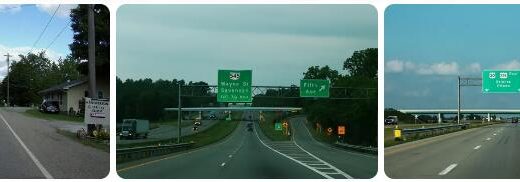United States Morphological Structure and Characteristics
The fundamental characteristic of the morphological structure of the United States is very well known, that is, the succession from E. to W., between the Atlantic and the Pacific, of three large longitudinal zones, extended throughout the country, so as to give it a grandiose uniformity of features. They are: the Appalachian system, with the plateaus and plains that flank it; the very extensive region of the central plains, and the area of the western highlands with mighty mountain ranges enclosing vast plateaus and intermontane alluvial basins (see america, II, the paper on p. 847). Of these three areas, the first is almost exclusive to the United States, the second is also found in Canada, but with considerably different characteristics in relation especially to climatic events; the third extends over the entire western section of North America.
The Appalachian system extends for approximately 2200 km. from the San Lorenzo estuary to Alabama, on an average width of 200-300 km. The deep transverse furrow marked by the Hudson and Mohawk rivers divides it into two sections: the northern one, of which the extreme group (M. Notre Dame, 1130 m.) Falls within the borders of Canada, while the entire mountains belong to the United States. of New England (M. Washington, 1914 m.) and the isolated group of the Adirondacks; the southern one, wider and higher, which is more properly named M. Allegani (M. Mitchell in the Black Mountains, 2044 m., Clingman’s Dome in the Smoky Mountains, 2030 m.). The Allegani are regular series of parallel chains and with tops that the demolition processes have made soft and rounded, water gaps). They facilitated the access of European settlers, from the maritime region, through the easternmost chain (Blue Ridge), compact as a sort of bastion, towards the internal territories. The Great Valley also served as an excellent artery of penetration.
The regularity of the relief is much less than N., where the orogeny was more complex and the general structure of the mountain is also complicated by intrusions of igneous rocks: the alternation of rocks more or less resistant to the processes of demolition and leveling it determined characteristic forms such as those designated by the name of monadnocks (solitary or series-aligned hills, which resisted demolition because they were made of harder rocks; the name derives from that of a mountain NW of Boston). Furthermore, the Quaternary glaciation has imprinted its traces in this northern section, which are missing in the real and proper Allegani (for other information, also on the genesis and morphology, see Appalachians, mountains).
The Blue Ridge usually falls very steeply towards a flat and undulating foothill area (Piedmont) and up to 150 km wide. to S., narrower as you proceed towards N., until it disappears between Delaware and Hudson; it is a regular plane, inclined from 700 to 200 m., interrupted by some rocky ridge, hollowed out by the valleys of the rivers tributary to the Atlantic. The Piedmont in turn declines towards the coastal plain with a plinth or step that the rivers jump forming waterfalls or cataracts; the alignment of these jumps, from Alabama to Delaware (fall line), is marked by grandiose plants that exploit the energy of rivers. These, having descended into the coastal plain, become navigable; several soon spread out into estuaries that have risen up from the tidal wave. The coastal plain, made up of Tertiary and Quaternary deposits, represents an ancient raised plain, engraved by valleys which sometimes continue into the underwater continental shelf. Up to 300 km wide. in correspondence to the southern section of the Appalachians, the plain narrows like the Piedmont, as one proceeds towards the N., and beyond the Hudson it reduces to a thin selvedge accompanied by islands. A positive bradyseism, mostly postglacial, submerged the eastern margins of the plain and determined the current coastal forms; the processes of erosion and marine accumulation that continue under our eyes have given them special characteristics. The aforementioned submersion is due to eg. the Cape Cod Bay and the shape of the sickle peninsula that ends at Cape Cod, as well as the separation of the Nantucket Islands, Martha’s Vineyard and smaller and especially Long Island. Both the inlet at the mouth of the Hudson and Delaware Bay, the largest and most indented Chesapeake Bay, Albemarle Sound, Pamlico Sound, Charlotte Harbor and Tampa Bay in Florida were created for the invasion of the river mouths., etc. Long sandy coastlines, originating from marine accumulation, in relation to the play of currents, then blocked those inlets into which large rivers did not flow. This barrage process, which naturally follows the gradual filling of the stretches of water left isolated behind the cords, it presents different phases in grandiose examples in the Albemarle and in the Pamlico Sound; very often outlets have been artificially maintained through the shores (inlet) for the entry of the tidal wave, which exerts a natural dredging function. Smaller inlets, of various shapes, always connected with submersion processes, meet at S. del Capo Fear; while the flat coast of Florida shows, especially in E., again very long coastal strips, rarely interrupted, behind which there are very low lagoons or, often, rather marshes, invaded by rich arboreal vegetation, sometimes real flooded forests (swamps). For Florida relief see this entry.
To the characteristics of such a coast we owe the frequency of shelters and capable and safe ports and therefore the lively development of maritime life and the rise of large commercial empires.
To the West, beyond the Great Valley, the Appalachian system is found with a steep escarpment edge (Allegheny Front), which in turn descends towards a series of highly troubled topography plateaus, engraved by the Ohio and its tributaries.
The region of the central plains extends from the aforementioned plateaus to the foot of the Rocky Mountains, from the great lakes to the Gulf of Mexico, but does not have the same characters and aspects everywhere. First of all, the altitude varies within very considerable limits, as demonstrated by the physical map in America: II, after p. 844; the route of the isoipsa of 200 m. shows how the vast southern peripheral portion, which can be designated as a lowland, is largely joined to the East. with the Atlantic coastal plain, and engulfs very deeply inland especially along the Mississippi and Ohio: St. Paul on the first of these two rivers, at 1800 km. from the mouth, it is just 214 meters above sea level and Pittsburgh, about the same distance from the sea, is 212. On Arkansas the altitude of 200 meters. it can be reached near Tulsa, and on the Missouri just downstream from Kansas. But to the North. and especially to the West the plain rises to very considerable heights, while retaining its character of horizontality: this is in fact found, towards the foot of the Rocky Mountains, still at 1000-1400 meters above sea level. The plain is constituted in its greater part by materials deposited at the bottom of the great Cretaceous sea and raised without much disturbance; above them are blankets of various horizons of the Tertiary, wind accumulation lands and, in the northern part, materials of glacial origin. Only the lower southern belt and its internal ramifications, along the major rivers, are made up of recent floods.
It can essentially distinguish, in this most extensive of the central plains region, four very different areas: a) the northern area – Mississippi prairies high and high Ohio – which rises slowly toward the Great Lakes, around which is a threshold, 250-400 m high, consisting of the moraines, now largely dismantled, which closed the lakes themselves to S. This area portrays its physiognomy mainly from the traces of the Quaternary glaciation: morainic strips, drumlins, and cavities barred by these deposits, dug or shaped by glaciers, today mostly occupied by lakes, of which there are thousands and thousands especially in the Upper Mississippi Basin; b) the western area, which insensibly rises towards the Rocky Mountains, has endless expanses of monotonous and level plains (Great Plains), interrupted only here and there by ridges, steps, low crests, such as the so-called Coteau des Prairies between the high Mississippi and Missouri, like the Ozark, Boston and Ouachita mountains, which with modest heights and level summits, but with sometimes very steep sides, continue the Appalachians, like the step with which to S. you climb towards the Llano estacado, an endless uniform plane, already placed largely at a height of over a thousand meters. The aridity of the climate gives all these plains of the O. aspects of desolation: in many parts one has to do with steppes or even with desert expanses; c) to the east of the Mississippi, morphologically corresponds to that recently described, the area that rises towards the Appalachian plateaus, but it is much more restricted, far less arid and more rugged due to the numerous streams that affect it and they exert considerable erosion work; d) fourth zone is the coastal plain) southern, which, on average 300 km wide, has characters not very dissimilar from that which stretches along the Atlantic: formed by alluvial debris, crossed by a dense network of waterways, has a very low, marshy coastal selvedge, and a slightly higher internal band, separated from the previous one by a slight step due to the presence of a layer of more resistant rocks than the ancient Tertiary. The coastal plain reaches its maximum width in the center, corresponding to the Mississippi valley; it narrows mainly to the W, towards the slopes of the eastern Sierra Madre; but on the border with Mexico, on the Rio Grande del Norte, it is still over 120 km wide. Here, too, the coast is bordered by long lagoons, separated from the sea by thin coastal strips; very regular especially those in O., such as Malagorda Bay and Laguna Madre; typical estuaries of drowned rivers, due to the marine invasion, are also here eg. Mobile Bay, Sabine Lake at the mouth of the Sabine, Galveston Bay, etc.; a more complex coastal section corresponds to the Mississippi delta (v.). Although the aforementioned estuaries often offer good ports, the coast of the Gulf of Mexico is much less conducive to seafaring life than the Atlantic coast.
The area of the western highlands, which is sometimes designated as a whole as the area of the Cordillera, and reaches in the United States a width, in the sense of the parallels, of almost 1700 km., Is essentially constituted, like the Andes, by a succession of plateaus flanked both to the East. and to the W. by mountain ranges; but this architecture, simple in its general lines, does not exclude a great variety of types and morphological aspects, also in relation with the geological events, extremely complex, and with the profoundly different climatic conditions in the various parts. The bundle of the eastern chains takes, as in Canada, the name of Rocky Mountains, but generally presents less harsh shapes, and due to the scarcity of snow and ice, due to the lesser diffusion of glacial traces (circuses with lakes, etc.), much less alpine than in Canada; moreover, the division of the mountain masses is greater, due to the presence of numerous large intermontane basins.
The chains usually rise steep and precipitate on the central planes, except to the NE. where you advance towards Missouri the outpost of the Black Mountains (Black Hills, 2176 m.), to the North. and E. of which are the famous Bad Lands, powerful clayey clods eroded and carved by myriads of bare, fan-shaped valleys, somewhat similar to our badlands. A large breach, through which some tributaries of the Missouri (North Platte, etc.) penetrate as far as the inner plateaus (crossed by the Green River), divides the Rockies of the United States into two sections: the northern one, characterized by uplifted penepians and then again engraved, therefore affected by deep valleys, interrupted by lake basins, closed between powerful eruptive masses; the second, in which the crests develop with greater continuity and compactness, with clearer parallelism. In the’national parks). In the northern section the maximum heights are reached in the Bighorn Mounts (Cloud Peak, 4013 m.), A block of granite and gneiss advanced towards the plain, in the Teton (Grand Teton, 4190 m.), And in the Wind River Range (Fremont Peak, 4202 m.; Gannet, 4185 m.) Which close the Yellowstone Park to the South. in the southern section the Colorado Front Range culminates with about forty peaks above 4000 m. emerging as a dome on a high level surface (M. Evans, 4346 m.; Long Peak, 4345 m., etc.), the Park Range (M. Lincoln, 4385 m.), the chain called Sangre de Cristo (Blanca Peak, 4386 m.), The Sawatch Range, which contains the highest peaks of all the Rockies (M. Massive, 4396 m.), The S. Juan Mts. (M. Wilson, 4344 m.). Less elevated are the southern appendages (Sierra Blanca, etc.) between Rio Grande del Norte and Rio Pecos. Among the westernmost chains, which already begin in Canada with the Selkirk, and continue with the Bitter Root Mts., The Wasatches have a place of their own, a long and rugged bulwark that closes the Great Basin to E. 3505 m.), Which is flanked by the Uinta group with the Emmons Peak (4093 meters) adergentesi on a typical leveling surface. (For a fuller description see.rocks, mountains).
The intermontane plateaus that succeed W to the Rocks form three distinct units. A N. is the Columbia plateau (about 510,000 sq km), crossed by this river and its tributary Snake River; huge and uniform expansion of lava materials, superimposed in successive flows (from the Miocene to the Quaternary) for a thickness of over 100 m., engraved in very deep canyons from the two watercourses mentioned above, it appears as an expanse of rock only partially degraded on the surface, on the whole very arid and therefore covered with steppes. At the center is the Great Basin, no less wide, but actually made up of a series of closed basins, at heights between 1200 and 1500 m. approximately, separated by short trunks of chains, today largely buried by blankets of alluvial debris, which atmospheric agents have torn from the highest and bare areas of vegetation. The most depressed areas form basins, sometimes dry, in which streams are lost among gravels and sands, sometimes they are instead occupied by lakes in the process of drying up: the largest, the Great Salt Lake is the modest residue of an extensive basin maybe 10 or 12 times more (see great salt lake).
To S., or better to SE. del Gran Basin, divided from this by the Wasatch wall, is the Colorado plateau, about 600,000 sq km wide, 2000 m high on average; uniform boarding, remained in the open from the Eocene onwards, but raised as a whole by about 1000 m. in some parts, without the horizontality of the arenaceous strata being disturbed, now engraved by the rivers in beds (mesas), separated by canyons. The most famous of them is the Grand Canyon of Colorado, about 250 km long, up to 1800 m deep. which reveals the whole series of layers up to the Archaeozoic, variously resistant and therefore with steep walls interspersed with terraces and bizarrely modeled in towers, pinnacles, etc., of the most diverse colors (see also cañón). The plateau is closed to the South. by the mountains of S. Francisco (Thomas Peak, 3504 m.), Through which the Colorado escapes to go, through a desert region, to G. di California. This desert region (Colorado, Gila, Sonora Desert), about 100,000 sq km wide, can be considered as the southern appendage of the intermontan basins; sometimes embraced as a whole with the name of the Great American Desert, it actually constitutes the largest desert area in North America with few oases, and depressed areas below the sea level (Death Valley or Death Valley, −84 m; Salton lake, −75 m.).
The area of the internal plateaus is in turn flanked, towards the West, by a double series of chains, between which long longitudinal grooves are interposed. They usually have the western side, facing the Pacific and beaten by humid winds, covered with forests and higher up covered with snow, and the eastern side, facing the plateaus, more arid and bare. The Coastal Chain of Canada is continued by the so-called Chain of Cascades, no longer coastal, but 150-200 km away from the sea. a thousand kilometers long and divided into two sections by the Columbia River. With a purely alpine landscape, it has imposing peaks, usually extinct volcanoes in recent times, such as Baker (3277 m.), Rainier (4391 m.), Shasta (4374 m.) And Lassen Peak (3188 m.) m.), still active, indeed the only active volcano, it seems, of the United States. The shortest trunk in the S. of the Pitt River valley (Sacramento) is called Sierra Nevada: not very high in the N., it grows in height towards S., where for about 300 km. it looks like a barricaded chain, with alpine shapes, peaks adergentisi beyond 4000 m., precipitous sides, evident glacial traces and numerous lakes. Maximum elevation is M. Whitney (4418 m.), Which, exceeding the highest peaks of the Rockies by a few tens of meters, is the highest peak in the United States. The chain houses areas famous for their picturesque character: among them the Yosemite valley, also praised for its superb vegetation.
Closer to the coast runs another chain, a continuation of the one that in Canada is broken up into the numerous coastal islands, while here it flanks the coast and therefore truly deserves the name of Coastal Chain. It starts in N. with the block, snowy and impervious Olympus (2478 m.), Then continues at 30-40 km. from the sea, broken into many trunks by the tributaries of the Pacific, whose mouths are sometimes drowned (Porta d’Oro), presenting only in S. sections elevated over 3000 m. (Sierra de San Gabriel, behind Los Angeles), without glaciers due to the southern latitude and dry climate. Even more barren and arid is the aspect of the sierras, which in continuation of the Coastal Range run through the peninsula of California, closest to the Pacific in the N. (Pico Santa Catalina, 3390 m.), Steeply descending on the Gulf of California at S. (see alsocalifornia).
Between the Coastal Range and the beams of the Cascade Range and the Sierra Nevada there is a longitudinal groove which can be considered as the continuation of that which, submerged in Canada, separates the series of coastal archipelagos from the continent. In the United States it begins with Pouget Sound, a complex and branched river valley drowned by the ingression of the sea, continues towards S. marked by a short right tributary of the Columbia, then by the Willamette. At the sources of this a detected threshold interrupts it; but in California it reappears, clearly indicated by the Sacramento and S. Joaquin valleys, forming together a valley corridor no less than 600 km long, an ancient marine gulf, filled with debris and river floods, today largely well cultivated, despite the scarcity of rains,
The west coast of the United States is much less favored than the east, above all because the mountains behind it cause difficulties in accessing the interior. On the other hand, the indentation that characterizes the Canadian coasts is missing and is there in connection with the Quaternary glaciation; for long stretches the coast is united, flat, imposing. The most notable inlets are valleys or systems of submerged valleys in the lower parts; such are Pouget Sound, Grays Harbor, the Columbia estuary, the magnificent “Golden Gate” that made the fortune of San Francisco, San Diego Bay and other minor ones. As will be seen below, the development of major ports is quite recent and is connected with the construction of rapid ocean-to-ocean communication routes.



